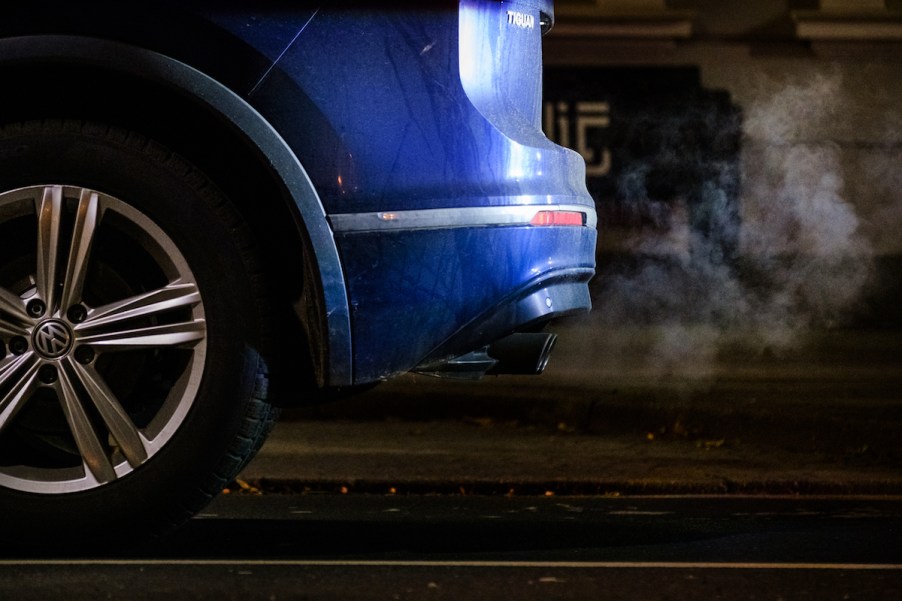
The EPA’s New Vehicle Emissions Requirements Just Got a Lot Stricter
In keeping with the Biden administration’s goal of lowering greenhouse gas emissions in the U.S., the Environmental Protection Agency recently announced new stricter fuel economy standards for cars. The transportation sector is the largest producer of heat-trapping pollution in the nation, contributing to climate change.
The new EPA rules reverse the weaker regulations for automakers under the Trump administration. Improving cars’ and light-duty trucks’ fuel economy is the goal.
Tough new vehicle emissions requirements

The Trump administration eased Obama-era emissions requirements. But this past August, the Biden administration came back with even stricter regulations than the ones Obama put in place.
The new emissions rule, finalized by the EPA in December and expressed in miles per gallon, results in a fleetwide average of around 40 mpg in 2026. That’s an improvement over 38 mpg proposed in August and 32 mpg using Trump-era rules, Automotive News reports.
The Biden and Obama administrations pushed for much stricter fuel-efficiency standards to cut down greenhouse gas emissions to combat climate change. At the behest of many environmental and state groups, the new rules will prevent around 3.1 billion tons of CO2 emissions through 2050.
The Biden administration has set a goal of requiring that 50% of all new vehicles sold in 2030 be fully electric or plug-in hybrid models.
Aggressively reducing pollution
EPA Administrator Michael Regan said in a statement: “We are setting robust and rigorous standards that will aggressively reduce the pollution that is harming people and our planet — and save families money at the same time.”
The current administration’s EV plans recently saw a setback when U.S. Sen. Joe Manchin, a Democratic conservative from West Virginia, said he could not support the $1.75 trillion domestic investment bill Build Back Better. The bill, whose fate is uncertain, includes new EV tax credits to help the nation’s Big Three automakers — General Motors, Ford, and Chrysler — meet the new rules.
According to the EPA, the vehicle emissions reduction benefits will exceed costs by as much as $190 billion. Drivers will save between an estimated $210 billion and $420 billion through 2050. The EPA also estimates that 17% of new U.S. vehicles will be EVs or PHEVs by 2026.
The new rules weren’t as strict as environmentalists wanted, but lawmakers had to add a provision for the automotive industry. Certain flexibilities are vital for automakers to meet the new standards.
How major automakers are doing their part to reduce emissions
The nation’s larger automakers have already shifted toward more environmentally friendly vehicles.
Ford plans to build two new EV platforms. The Blue Oval debuted the Mustang Mach-E in 2021 and unveiled the F-150 Lightning for 2022. Earlier this year, the automaker announced plans to develop two additional EV platforms. One will be for cars and crossovers, while the other will be for pickup trucks and large SUVs.
The move will allow Ford to produce a wide variety of EVs to appeal to a broad range of car buyers. Shared platforms offer the added benefit of using the same batteries, chassis, and motors to meet an array of consumer needs.
Some automakers, such as Mercedes-AMB, are increasing the fuel efficiency of combustion engines. AMG’s new E Performance hybrids use F1-derived engine technology to produce such engines — one a 4.0-liter V8 producing more than 800 hp.
Though top automakers are increasing the number of EVs and hybrids they produce, the market isn’t there yet. It’s estimated that Ford will sell 473,000 EVs in 2022, while GM will sell 600,000 by 2025. Tesla remains the top seller, intending to outsell each year by 40% to 50%.
Once new federal tax incentives are resolved, it’s anticipated that a new interest in buying EVs will result.


